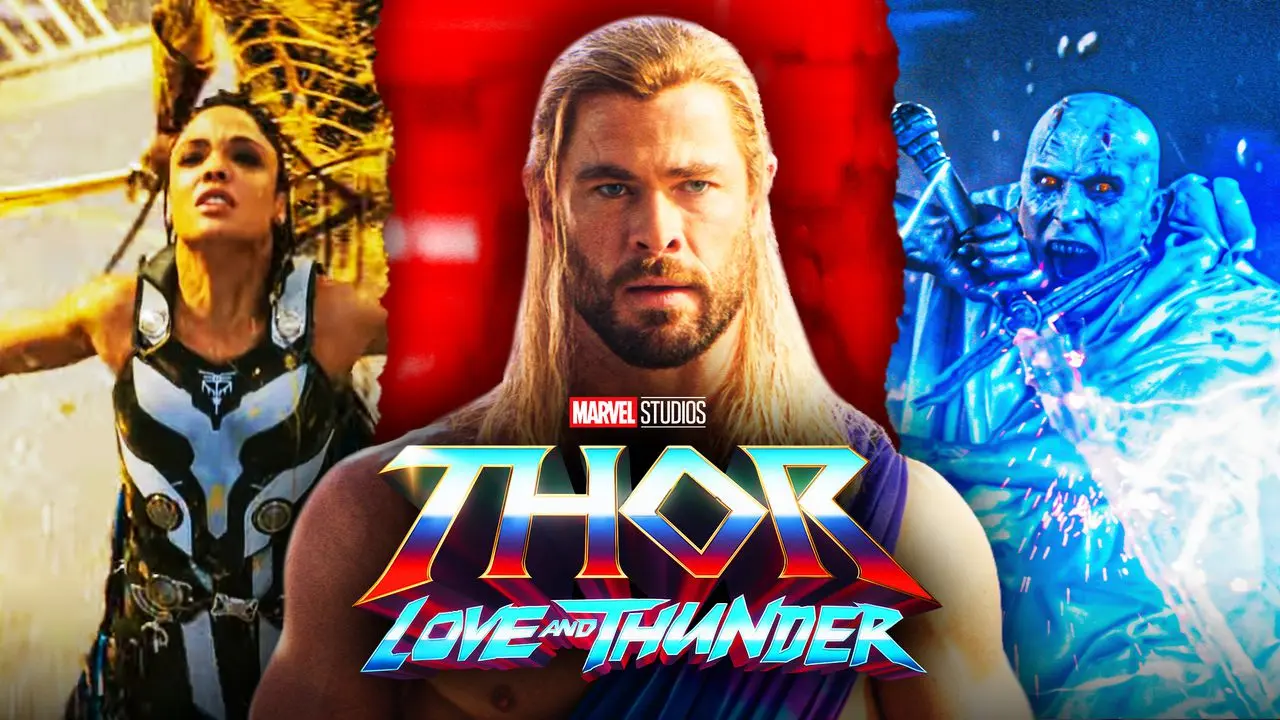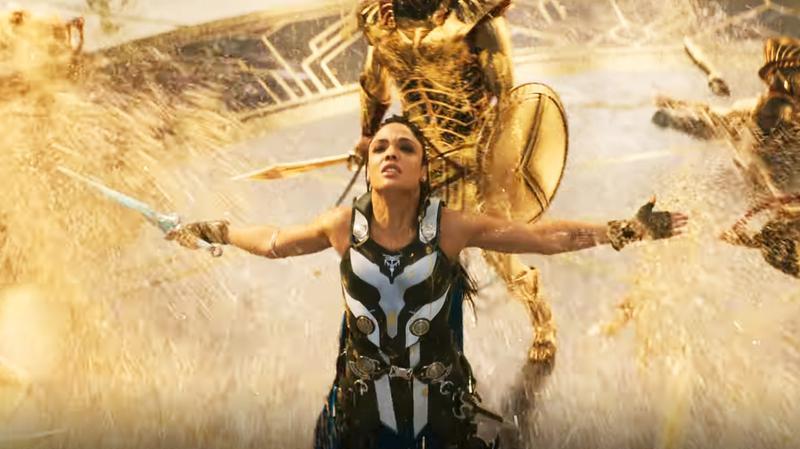
Thor: Love and Thunder has finally landed in theaters. Chris Hemsworth is back, this time going up against Christian Bale’s Gorr the God Butcher. Thankfully he’s not alone, as Natalie Portman’s Mighty Thor and Tessa Thompson’s Valkyrie are there to help him out. Sadly, their helping hands didn’t seem to be enough to combat the mixed reviews the project has been getting.
While the film had one of the best Thursday openings for an MCU movie, it scored a relatively abysmal B+ CinemaScore—one of the lowest for any Marvel Studios project ever.
But what’s all the fuss about? Why do people seem to have so many issues with the movie? Well, let’s take a look at some of the biggest complaints.
Lightning Speed

The most common complaint about Taika Waititi’s recent film is that the pacing is not so great. This isn’t too much of a surprise since the movie is one of the shortest MCU films ever at less than two hours long.
The problem is noticed because, at most times, it feels as if the plot is just rushing from one point to another. The transitions between scenes can be rough, which can also lead to jarring tonal shifts—especially with a project trying to balance both drama and comedy like this one.
In this case, with the film’s breakneck pacing being an issue, a longer runtime may have helped eliminate this problem. Or, at the very least, it could have smoothed the edges a bit more.
The CGI

Marvel has been having a rough time with its CGI as of late. Doctor Strange in the Multiverse of Madness was iffy at times, Ms. Marvel’s new light construct powers don’t look great, and She-Hulk could use loads of improvement.
Sadly, that issue has reared its ugly face in Love and Thunder.
Now the biggest element causing the issues? The famous Volume LED technology—the same used on both The Mandalorian and Obi-Wan Kenobi. It’s basically an advanced green screen that puts the actors into the environment in real-time.
The problem? Due to flat lighting, iffy shot composition, and shoddy set design, many of the various backdrops have no depth to them. They immediately stand out and are very easy to spot. It ends up looking no better than a cheap greenscreen or worse.
Eagle-eyed viewers may also notice how sets using this technology tend to be more circular in nature—something which sticks out the moment the backdrop fails to maintain the illusion.
The film’s classical CGI doesn’t look all that great either. Many point specifically to the black and white fight on the moon, the two new goats, Chris Hemsworth’s temporary helmet, and Korg himself.
Marvel needs to take a step back and put more time and effort into its VFX. Hire more studios and give them a bigger window to deliver the final product. If they don’t, this problem will only get worse as time goes on.
Too Many Stale Jokes and a Poor Balancing Act

Ironically, the humor in Love and Thunder doesn’t cause the same issue it did in Ragnarok, where it trampled over emotional beats. This time around, those beats are safe, but the movie is still filled with an obnoxious amount of jokes—the problem being that most of them didn’t land for much of the audience.
The first hour of the movie ends feeling like an endless train of jokes more than anything else. It comes off as if Taika Waititi is throwing things at the wall and seeing what sticks.
Even the entire Guardians of the Galaxy feel like they’re only there for a gag so that the director can rush them out of his film.
As mentioned above, the drastic tonal shifts between and during scenes didn’t always work for viewers either. This is the product of the story inadequately balancing its funny and serious moments, which, to their credit, is a difficult feat to accomplish in the first place.
The moral of the story? Quality over quantity, Waititi—more isn’t always better.
Gorr Doesn’t Go the Distance

Christian Bale provides an incredible performance as Gorr, no doubt. But what the character needed was far more time on screen.
For one, his backstory held back for no reason. In the comics, he loses his mother, then his wife, and then his children, thanks to starvation. That’s some heavy trauma to carry, which would have made his snap far more believable.
Sure, he does touch the Necrosword, which then starts to corrupt him, but intensifying that backstory could have done wonders. In theory, it would have also led to more scenes with his daughter, making the end of the movie hit harder.
His name is Gorr the God Butcher, and throughout the whole movie, audiences actually only see him kill one God. It makes the threat feel far less impactful, and he never truly feels like a danger.
Had the story gone and shown us how he killed and bested a multitude of Gods, then there would have been far more heft to Gorr’s story. They even had the perfect set-up for it with Thor in Omnipotent City—plenty of casualties just waiting to happen.
Not Enough Jane Foster

Natalie Portman was fantastic as Mighty Thor. Her return was very welcome, and her dynamic with both Chris Hemsworth and Tessa Thompson was aces.
However, like Gorr, she could have used more time on screen. Mainly, the film would have benefitted from some more exploration of her troubles with cancer—and her history regarding the disease and her late mother.
Thankfully, her emotional beats still played well with what audiences got, but they could have hit harder.
Additionally, some feel the movie did a disservice in skipping past her transforming into the Mighty Thor for the first time. After all, the more of Portman having fun with Mjolnir, the better.
On a similar note to both Jane’s Thor and Bale’s villain, Valkyrie could have used some more love as well. She was great in most of the movie but then got sidelined. While it made sense to make sure the focus shifted to Jane and Thor in those pivotal climactic moments, Tessa Thompson’s hero could have been given something else to do—like help the children, for example.
Doesn’t Go Far Enough

The entire idea behind Gorr is to explore the concept of putting faith in a higher power. What happens when that higher power doesn’t exist, or worse, simply ignores you?
Past the opening scene of the film, that theme is almost entirely dropped. It was a thematic thread that should have weighed heavily on Thor; what does he mean to the people who look up to him? Are Gods even worthy of love and praise given all they don’t do?
In the comics, Thor comes to realize that the answer is no—causing him to become unworthy of Mjolnir. This eventually leads to Jane being the one to pick it up next, though it clearly played out in a far simpler fashion in the movie.
It’s quite simply a waste to have left that philosophical and morally questionable goldmine behind, thanks to how Love and Thunder adopted Gorr.
Furthermore, the mythos of what Gods are in the Marvel Cinematic Universe is still frustratingly vague. This was the perfect time to start exploring all of that—but the best we got was just a little bit of information on Zeus and his orgy city.
Plot Conveniences

Writing a movie is hard, there’s no doubt about it. Scripts get rewritten dozens and dozens of times to make sure the final product is the best it can be.
When it comes to Thor: Love and Thunder, it could have used a few more drafts. The story is filled with plot conveniences or questionable continuity gaffes.
One example is in how the group’s visit to Omnipotent City goes. Their reasoning for the trip is for them to gather a group of Gods to help in their crusade against Gorr. However, not only do they quickly make up their minds that the Gods won’t help them, but Valkyrie then suddenly becomes obsessed with Zeus’ lightning bolt.
There’s absolutely nothing even hinting that the weapon is particularly special in any way or how it could give any specific advantage over Gorr. All it ended up doing was giving Val a weapon to use and then conveniently being there for Thor when he lost Stormbreaker later in the movie.
This is far from the only example of lazy writing. Another would be the pure existence of Heimdall’s son, who was only created as a plot device so that Thor could talk with the children.
Then there are inconsistencies in continuity when it comes to Thor’s abilities—all so that the plot can get from A to B. For one, how can Zeus’ lightning bolt function like the Bifrost? Also, since when can Thor just temporarily grant his powers to groups of people, using another God’s weapon no less?
The writing needed the story to advance in a certain direction, and the writers could have used more time to smooth the journey out so that it all felt more organic and not rushed.
Also, Thor certainly found out where Eternity was pretty fast for a location that no one has theoretically made it to up until this movie.
Thor: Love and Thunder in a Mixed Bag

For those who enjoyed this project, and feel like everyone is making a fuss for no reason, know that there’s nothing wrong with still liking—or even loving—it. But it’s always good to at least see where the other side is coming from, especially when the chorus of unsatisfied viewers is particularly loud.
Even with all of the above issues, and for those who felt unsatisfied with the end result, it would be hard to claim the movie a complete failure. There’s plenty that still works well in Love and Thunder and there's lots of fun to be had.
Hopefully, Thor’s next adventure can patch up some of these rough spots. After all, it’d be a shame if Thor’s big showdown with Hercules was a disappointment.
Thor: Love and Thunder is now playing in theaters worldwide.












